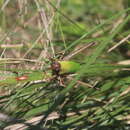pt-BR
nomes no trilho de navegação


Thoracistus is a genus of decticine or shield-backed katydids in the family Tettigoniidae.[1] The mostly carnivorous genus is endemic to South Africa.[2]
This genus of decticine is extreme in the extent of its inflated pronotum. The pronotum completely conceals the tiny wings, which are used for stridulation only.[2] The pronotum functions as a resonating chamber, to amplify the singing of the male. As in all decticines a "free plantula" is found at the base of the tarsus of the jumping leg. This pair of elongate pads may aid jumping in ground biomes.[2]
They are bush or ground-dwelling insects, but unlike the majority of decticines, occur in mesic rather than xeric habitats. They hide by day in thickets, and become active at dusk when they ascend plants to feed on smaller insects.[2] After dark males call to the females, which are silent. The sound of a male chorus can carry some distance. The eggs hatch from late spring to early summer. They reach adulthood from late summer to fall.[2]
Species include:
{{cite book}}: |first1= has generic name (help) Thoracistus is a genus of decticine or shield-backed katydids in the family Tettigoniidae. The mostly carnivorous genus is endemic to South Africa.
Thoracistus es un género de saltamontes longicornios de la subfamilia Tettigoniinae. Se distribuye en el sur de África.[1][2]
Las siguientes especies pertenecen al género Thoracistus:[1]
Thoracistus es un género de saltamontes longicornios de la subfamilia Tettigoniinae. Se distribuye en el sur de África.
Thoracistus is een geslacht van rechtvleugeligen uit de familie sabelsprinkhanen (Tettigoniidae). De wetenschappelijke naam van dit geslacht is voor het eerst geldig gepubliceerd in 1888 door Pictet.
Het geslacht Thoracistus omvat de volgende soorten:
Thoracistus is een geslacht van rechtvleugeligen uit de familie sabelsprinkhanen (Tettigoniidae). De wetenschappelijke naam van dit geslacht is voor het eerst geldig gepubliceerd in 1888 door Pictet.